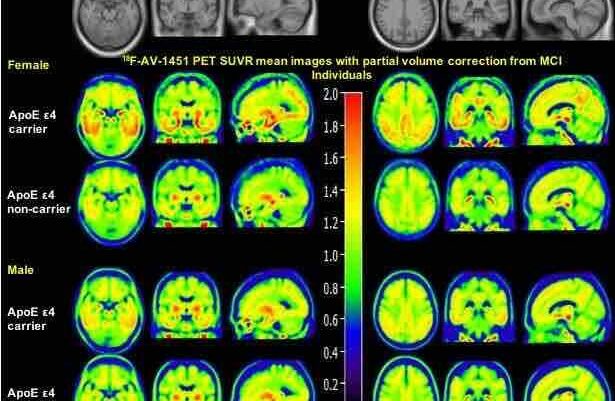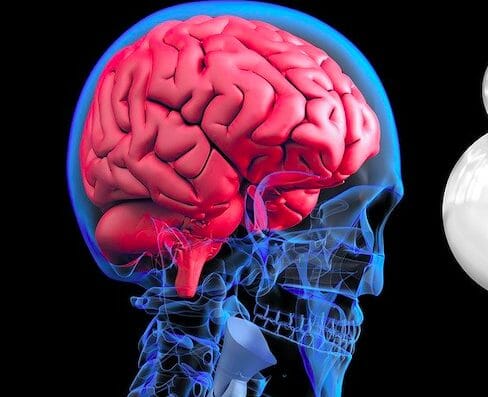Researchers in Germany studied the effects of ApoE4, the best known genetic factor for Alzheimer’s Disease, on the brains of 82 young adults — they found surprising results.
People with a certain gene variant ApoE called ApoE4 have a genetic predisposition to late-onset Alzheimer’s disease. Recent research has found that this tricky variant may also make its carriers more likely to have blood-brain barrier dysfunctions, more susceptible to developing mild cognitive impairment when taking anticholinergic drugs, and other neurological issues.
Now, research from the German Center for Neurodegenerative Diseases and the Ruhr-Universität Bochum recently published in Current Biology have found that the impacts of gene variants begin much earlier in life than any neurological symptoms generally appear. It may affect how the brains of people as young as the age of 20 manage certain memory tasks.
“We were interested in finding out whether and how the different gene variants affect brain function. That is why we examined the brains of young adults in the scanner while they had to solve a task that challenged their memory,” lead author Dr. Hweeling Lee, at the German Center for Neurodegenerative Diseases, said in a news release.
Their findings are based on studies with magnetic resonance imaging in 82 cognitively healthy young men and women an average of 20 years old. The scientists suspect that the observed effects could be related to very early disease processes.
Everyone has two copies of the ApoE gene, but there are several variations, including ApoE2, ApoE3 and ApoE4. The combination you have determines your ApoE genotype. ApoE3 is the most common and doesn’t seem to influence risk for Alzheimer’s, while the E4 allele, which is present in 10 to 15 percent of people, increases the risk for Alzheimer’s and lowers the age of onset. Having one copy of E4 can double or triple your risk, and having two copies — E4/E4 — can increase Alzheimer’s risk by a factor of 12.
According to their genotype for ApoE, 33 study participants had an average risk of developing Alzheimer’s later in life, 34 had the increased risk that comes with the ApoE4 gene variant, and 15 had a reduced risk of developing Alzheimer’s disease.
While undergoing brain scans, study participants watched a monitor that displayed a succession of more than 150 images of everyday objects: a hammer, a pineapple, a cat, etc.. Some repeated, and if they were shown twice, they might be shown in a different location on the monitor screen.
Study participants were asked to identify whether an object was new to them, or if it had been shown before, and if the latter, whether its position on the screen had remained the same or shifted.
“We tested the ability to distinguish similar events from one another. This is called pattern separation,” Lee said. “In everyday life, for example, it’s a matter of remembering whether a key has been placed in the left or right drawer of a dresser, or where the car was parked in a parking garage. We simulated such situations in a simplified way by changing the position of the depicted objects.”
While participants were watching the images, Lee’s team monitored their brain activity using a technique called functional magnetic resonance imaging.
They focused on the hippocampus — the brain’s switchboard of memory. When Alzheimer’s disease appears, damage starts to appear first in the area of the brain where the hippocampus is located, leading to confusion and memory loss.
When measuring brain activity, the scanner was able to show its full potential: It was an “ultra-high field tomograph” with a magnetic field strength of seven Tesla. Such devices can achieve a better resolution than brain scanners usually used in medical examinations. This enabled the researchers to record brain activity in various sub-fields of the hippocampus with high precision. “Up to now, there were no comparable studies with such level of detail in ApoE genotyped participants. This is a unique feature of our research,” said Hweeling Lee.
Differences In Brain Activity Based on the Alzheimer’s Risk Gene ApoE4
There were no differences between the three groups of subjects with regard to their ability for seperating pattern. “All study participants performed similarly well in the memory test. It did not matter whether they had an increased, reduced or average risk for Alzheimer’s disease. Such results are certainly to be expected in young healthy people,” Ruhr-Universität Bochum study researcher and professor of neuropsychology Nikolai Axmacher said.
“However, there were differences in brain activity. The different groups of study participants activated the various subfields of the hippocampus in different ways and to varying degrees. Their brains thus reacted differently to the memory task. In fact, we saw differences in brain activation not only between people with average and increased risk, but also between individuals with average and reduced risk.”
The researchers say that it is not possible to tell without further and longer-term research whether these differences have any bearing on the likelihood of a person to develop Alzheimer’s late in life or at the point when genetically high-risk individuals develop Alzheimer’s. But the earlier Alzheimer’s can be detected, theoretically, the earlier it could be treated once those treatments exist. Knowing how Alzheimer’s affects the brain can also aid in drug development.
“Our findings might be related to very early disease processes. Determining this is a task for future studies and could help to devise biomarkers for the early diagnosis of dementia,” Lee said.
“In any case, it is remarkable that a genetic predisposition for Alzheimer’s disease is already reflected in the brain at young adulthood.”





